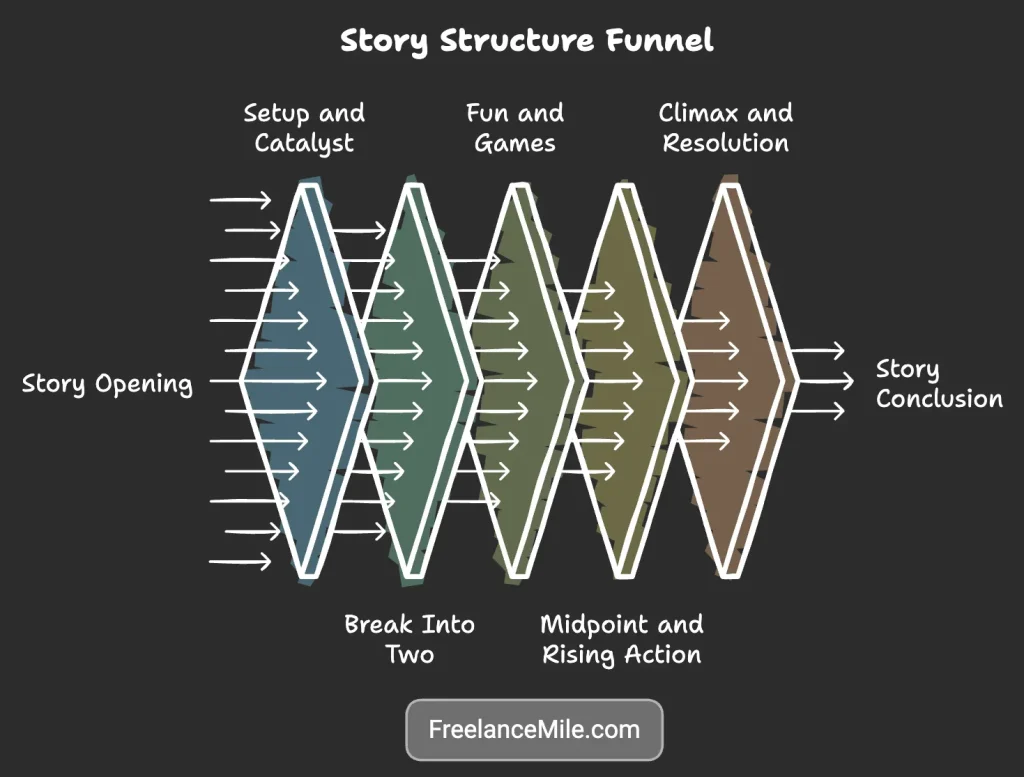To make a perfect book outline, start with your main idea. Then, find key plot points and create interesting characters. Next, organize your outline and make it better. A good outline is like a map for your writing journey. It helps you keep your thoughts in order and stay focused.
If you want to know more about these steps, read on. Need help with book outlines? Ask in the comments at the end, and I’ll help you.
Creating a book outline is key to writing a good story. It helps you plan your story, characters, and plot. Whether you write by the seat of your pants or plan everything out, a good outline makes writing easier.
There are many ways to outline your novel. You can use Mind Maps, Synopses, or the Snowflake Method. Randy Ingermanson’s Snowflake Method is very popular. These methods help you build a strong story structure.
Remember, your outline is just a guide. It’s meant to excite and inspire you. As you write, you might change your plan. That’s okay. The goal is to have a solid base to grow your story from.
Key Takeaways
- A book outline helps organize thoughts and maintain focus while writing
- Various outlining methods exist, catering to different writing styles
- Famous authors like J.K. Rowling use outlines to structure her stories
- Outlines can range from simple summaries to detailed chapter breakdowns
- The outlining process can reveal potential issues in your initial story idea
- Your outline should be flexible and adaptable as your story develops
Understanding the Importance of a Book Outline

A novel outline is like a compass for your story. It guides you through the journey of writing. It’s a powerful tool that can make your writing better.
Benefits of outlining your novel
Creating a plot outline has many benefits. It helps you organize your ideas and keep your story consistent. It also helps you find and fix problems early.
With a good outline, you can write faster. This means you’ll spend less time writing and more time enjoying it.
Addressing common misconceptions about outlines
Some think outlines limit creativity. But that’s not true. An outline gives you a structure to explore and try new things.
It lets you dive deep into your characters and plot. You won’t lose sight of what your story is about.
How outlines enhance creativity and productivity
A good outline makes you more productive. It gives you a clear path to follow. This helps you avoid getting stuck & keeps you writing smoothly.
With an outline, you know what to do next. This saves you time and lets you focus on writing.
Your outline can change as you write. It lets you be spontaneous while staying on track. Learning to outline well will help you succeed in writing your novel.
Choosing Your Outlining Method
Choosing the right outlining method is key to your writing success. There are many methods to choose from, each with its own benefits. Let’s look at some popular ones to help you pick the best for your story.
Mind maps are visual tools that connect characters, plot points, and events. They’re perfect for brainstorming and seeing your story’s big picture. If you think in pictures, mind maps might be for you.
Synopsis writing is about making a short version of your novel. It helps you quickly grasp your story’s essence. This way, you can spot any problems with your plot or pacing early.
Character-driven outlines focus on character arcs and conflicts. This method is great for stories that center around complex characters and their relationships.
| Outlining Method | Key Feature | Best For |
| Mind Map | Visual connections | Visual thinkers |
| Synopsis | Brief story version | Quick plot overview |
| Character-Driven | Focus on arcs and conflicts | Character-centric stories |
Remember, there’s no single best way to outline. You might find mixing different methods works best for you. The most important thing is to pick a method that fits your writing style and story needs.
Step 1: Crafting Your Story’s Foundation
Building a solid foundation for your story starts with a great story idea. This step is key for your whole writing journey. Let’s look at how to build a strong base for your novel.
Developing Your Main Idea or Premise
Your story idea is the heart of your book. Make a short elevator pitch that shows what your story is about. For example, “Astronaut stranded on Mars fights to survive.” This simple idea can help guide your writing.
Identifying Key Plot Points
Plot points are the core of your story. They include the opening scene, the inciting incident, major conflicts, and the resolution. Plan out these key moments to guide your story.
Creating Compelling Characters
Your main character and supporting cast make your story come alive. Know their goals, motivations, and conflicts. Make sure their character arcs show growth as the story unfolds.
| Element | Description | Impact on Story |
| Story Idea | Central concept or premise | Guides entire narrative |
| Plot Points | Key events in the story | Drives story progression |
| Characters | Individuals in the story | Brings story to life |
| Character Arc | Character’s journey and growth | Adds depth and engagement |
By focusing on these key elements, you’ll build a strong foundation for your novel. Remember, a well-thought-out story premise can help keep your novel focused, reducing the chance of it getting scattered by up to 25%.
Step 2: Structuring Your Book Outline
Making a strong story structure is crucial for your book’s success. Your plot outline is the main part of your story. It guides readers through your tale. Let’s look at the key parts of a chapter outline to make a compelling story arc.
Begin with your opening image. It sets the mood for your whole book. This happens in the first 1% of your story. By the 5% mark, introduce your theme.
The setup, from 1% to 10%, prepares your plot. At the 10% point, introduce your catalyst event. This starts the debate section, which goes until the 20% mark. Here’s where your story really starts:
- 20%: Break Into Two – Your protagonist enters the main storyline
- 22%: B Story begins – Often a romantic subplot or character development arc
- 20% to 50%: Fun and Games – The meat of your story unfolds
- 50%: Midpoint – A major turning point in your narrative
The second half of your book gets more intense. From 50% to 75%, the antagonists get stronger. At 75%, your protagonist hits rock bottom. This leads to the dark night of the soul (75% to 80%), followed by a breakthrough at 80%.
Your finale goes from 80% to 99%, tying up loose ends and building to a climax. End it with a final image that mirrors or contrasts your opening. This brings your story full circle.

Remember, this plot outline is a guide, not a strict rule. As you write, you might change it. That’s okay – being flexible is part of being creative. The main thing is to use this structure as a roadmap. It helps make sure your story hits all the right beats at the right times.
Step 3: Fleshing Out Your Scenes
Making scenes interesting is key to a great novel. A good scene outline helps you tell stories that grab readers. Let’s see how to make your scenes come alive.
Determining Scene Objectives
Every scene in your book must have a reason. When making your scene outline, think about what each scene does. Does it move the story forward? Show what characters are like? Set the mood? Knowing what each scene does keeps your story on track.
Incorporating Conflict and Tension
Conflict and tension make stories exciting. In your scene outline, find conflicts – like arguments or tough choices. Add tension to keep readers eager to know what happens next.
Balancing Action and Dialogue
A great scene mixes action and talk. Your scene outline should show important moments and key talks. Find a balance to keep the story moving and show how characters grow.
| Scene Element | Purpose | Example |
| Objective | Drive plot forward | Protagonist discovers a clue |
| Conflict | Create tension | Argument between characters |
| Action | Engage readers | Car chase scene |
| Dialogue | Reveal character | Heart-to-heart conversation |
Your scene outline is like a map. It helps you navigate your story and lets you be creative. By focusing on what each scene does, you’ll make scenes that grab readers from the start.
Step 4: Developing Character Arcs
Character arcs make your story come alive. They show how your main character changes from the start to the end. Think about their goals, challenges, and inner struggles.
There are 4 main types of character arcs:
- Moral Ascending Arc
- Moral Descending Arc
- Transformational Arc
- Flat Arc
When making your character arc, focus on these important parts:
- Want
- Need
- Motivation
- Fear
- Flaws
- The Lie
- The Ghost
To make a strong character arc, follow these steps:
- Define your character’s initial state
- Establish their goal
- Introduce challenges
- Let them fail
- Repeat challenges and failures
- Force confrontation with their core beliefs
- Allow triumph or fall
- Showcase their new normal
Don’t forget, character growth is for everyone, not just the hero. Side characters should grow too, helping the story along. Use your outline to keep track of each character’s journey. Make sure their arcs fit the story’s structure.
Book Outline Templates and Tools
Writing a book can feel overwhelming. But, the right tools can help a lot. Let’s look at some popular tools for making your novel outline. We’ll see how to make them fit your needs.
Popular Outlining Software Options
Many writers use special software to organize their ideas. Here’s a look at some top picks:
| Software | Key Features | Best For |
| Scrivener | Corkboard view, research organization | Long-form projects |
| Plottr | Visual timeline, character development | Plot-driven stories |
| Squibler | Built-in templates, distraction-free mode | Efficient book creation |
Adapting Templates to Fit Your Needs
Book writing templates are super helpful, especially for new authors. In fact, 86% of new writers find starting from scratch hard. They prefer outlines. You can find templates for different genres in Microsoft Word or Scrivener.
The important thing is to pick a template that’s detailed but also lets you add your own touches. This way, it fits your story perfectly.
Creating a Custom Outline Format
If you can’t find the perfect template, make your own! Start with these basics:
- Main characters and their reasons
- Setting and its limits
- Key plot points (5-15 for non-fiction)
- Chapter hooks (personal stories, questions, or shocking statements)
- Thesis statement for each chapter
There’s no one-size-fits-all rule for outline length. Just make sure to cover the big points and character growth. With the right tools, you’ll get your book written in no time.
Step 5: Refining Your Book Outline
Refining your book outline is key in writing. It’s about making your story flow well. You’ll need to go through it many times.
First, check if your outline makes sense and moves at a good pace. Make sure each part adds to the story. If not, change or remove it. This makes your story tighter and keeps readers interested.
Ask for feedback from others. Beta readers or writing groups can spot problems. Remember, it’s about making your story better, not just fixing spelling.
Bernard Malamud, renowned novelist and short story writer, highlights the joy of refining and improving one’s work, appreciating the creativity that comes with revisiting and reimagining initial ideas.
Focus on your characters during this stage. Make sure their stories are clear and their reasons for acting are obvious. This makes your characters come alive.
Doing this now saves you time later. A good outline guides you as you write. It helps you stay on track.
Overcoming Common Outlining Challenges
Writing a book outline can be tricky. You might face hurdles that slow down your creative writing process. Let’s explore ways to tackle these obstacles and keep your story moving forward.
Dealing with Writer’s Block
Writer’s block can strike during outlining. To break through, try freewriting for 15 minutes. This can spark new ideas for your story. If you’re stuck on one part, skip to another section of your outline. Sometimes a change of focus is all you need to get unstuck.
Maintaining Flexibility in Your Outline
Your outline is a guide, not an strict rule book. Keep it flexible to allow for new ideas. If you feel boxed in, take a step back and reassess. You might find fresh angles that improve your story.
Balancing Planning and Spontaneity
While planning is crucial, leave room for spontaneity in your writing process. Surprise yourself with unexpected plot twists or character developments. This balance keeps your writing exciting and prevents your outline from becoming too rigid.
| Challenge | Solution | Benefit |
| Writer’s Block | Freewriting, Changing Focus | Sparks Creativity, Maintains Momentum |
| Inflexible Outline | Regular Revisions | Allows for Story Evolution |
| Over-planning | Leave Room for Spontaneity | Keeps Writing Fresh and Exciting |
Remember, 60% of first-time novelists struggle with chronic indecision while drafting. By addressing these common challenges, you’ll be better equipped to create a compelling book outline and kickstart your writing journey.
From Outline to First Draft: Making the Transition
Are you ready to turn your outline into a first draft? This is a big step in your writing journey. Your outline is like a map, showing you the way through your story. It lets you take creative turns along the way.
Begin by making your outline’s main points into full scenes and chapters. Don’t worry too much about making it perfect yet. Your first draft is all about exploring and finding out.
| Outline Element | First Draft Expansion |
| Main plot points | Detailed scenes with dialogue and action |
| Character descriptions | Character development through interactions and inner thoughts |
| Setting notes | Rich, sensory descriptions of environments |
| Conflict ideas | Fully fleshed out confrontations and obstacles |
It’s okay if your first draft changes from your outline. This can lead to new plot twists and character growth. These surprises can make your story even better.
Terry Pratchett, renowned fantasy author, suggests that the initial version of your writing is essentially a personal narrative development stage.
While writing, keep your outline handy but feel free to jump around. Start with the easier parts to get going. This can help you avoid writer’s block and keep moving forward in your novel.
Revising and Updating Your Outline During the Writing Process
Writing a book is a dynamic process. Your outline is a guide, but it can change. As you write, new ideas and directions will come up. It’s important to update your outline often.
Studies show writers revise their outlines at three times. Before starting, during writing, and after finishing. This helps your story grow while keeping it structured.
During the first draft, you might need to change your outline. How much you change depends on your original plan. Some writers find their outline grows as they write.
“Revision is where the real writing happens.”
After your first draft, you might do reverse outlining. This means making a short summary of your story. It helps you see if your story is balanced.
| Writing Stage | Outline Revision | Purpose |
| Pre-First Draft | Initial Outline Creation | Set story direction |
| During First Draft | Ongoing Adjustments | Incorporate new ideas |
| Post-First Draft | Reverse Outlining | Identify structural issues |
Remember, updating your outline is normal. It keeps your story consistent and clear. Don’t be scared to make changes – it will make your story better.
Conclusion
Learning to make a good book outline is key for writing a novel. These tips will help you start strong. Remember, your outline can change as you get new ideas.
We talked about different ways to organize your story. Your outline is like a map, helping you write while keeping things fresh.
Don’t worry if your outline changes. It’s meant to grow with your story. It helps you stay on track, fight writer’s block, and make your book exciting. With these tips, you’re ready to start your first draft and write a story that grabs people’s attention.







